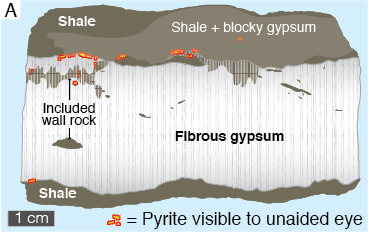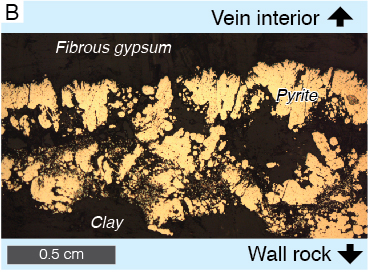Mars-analogue calcium sulfate veins record evidence of ancient subsurface life
- 1UK Centre for Astrobiology, School of Physics and Astronomy, University of Edinburgh, Edinburgh, United Kingdom
- 2Department of Geology and Geophysics, University of Aberdeen, Aberdeen, United Kingdom
Abstract: Calcium sulfate mineral veins cross-cut fluviolacustrine sedimentary rocks at many localities on Mars. Although these veins probably formed under habitable conditions, their potential to retain ancient biosignatures is poorly understood. Here, we report ancient biogenic authigenic pyrite (FeS2) lining a fibrous gypsum (CaSO4.2H2O) vein of probable Cenozoic emplacement age from Permian lacustrine rocks in Northwest England. The observed pyrite distributions and textures suggests that the pyrite formed replacively after gypsum within the veins and was not inherited from the host rock. Spatially resolved ion microprobe (SIMS) measurements reveal that the pyrite sulfur isotope composition (δ34SVCDT) is negatively offset from the host gypsum by ~40‰. We infer that the pyrite was precipitated in the deep subsurface by microorganisms living in porosity at the vein margins, which coupled the reduction of vein-derived sulfate to the oxidation of wall-derived organic matter. This implies that such veins can incorporate biosignatures that remain stable over geological time, which could in principle be detected in samples returned from Mars [1].
Introduction: Fibrous, antitaxial calcium sulfate veins were encountered by the MER rover Opportunity in Endeavour Crater and are inferred to represent gypsum [2,3]. Similarly, white calcium sulfate veins (anhydrite, bassanite, and perhaps gypsum) cross-cut hundreds of metres of fluviolacustrine and aeolian stratigraphy traversed by the MSL Curiosity rover in Gale Crater, including the Yellowknife Bay and Murray formations [4,5,6,7]. Some of these veins are thought to post-date lithification and to have formed at depths of over 1 km in the subsurface [8]. Veins like these may be encountered in future by the Perseverance and Rosalind Franklin rovers, and have sometimes been discussed as an attractive target for astrobiological investigation, but their potential to preserve biosignatures is poorly understood. Here, we summarise a new study [1] of ancient biosignatures in ancient (Cenozoic), bedding-parallel, antitaxial veins of white, fibrous gypsum found in Permian lacustrine mudrock. These veins are located in the Eden Shales Formation of the Vale of Eden Basin, Cumbria, NW England, and were sampled underground in situ in the Kirkby Thore gypsum mine.


Figure 1: Pyrite at the margins of a gypsum vein. A: Sketch of hand sample. B: Reflected light photomicrograph showing brassy pyrite with complex microdigitate morphology at gypsum vein margin.
Results: Pyrite was observable to the unaided eye at the margins of the gypsum veins in polished hand samples (Figure 1A); its composition was confirmed with energy-dispersive X-ray spectroscopy. The pyrite displays a complex interfingering boundary with the surrounding gypsum, suggestive of replacive authigenic growth (Figure 1B; we do not consider this morphology itself a biosignature). Gypsum-entombed carbonaceous material of probable organic origin was identified by Raman spectroscopic microscopy in close proximity to the pyrite (from its prominent D- and G-bands); authigenic dolomite is also present. Spatially resolved ion microprobe (SIMS) measurements reveal that the pyrite sulfur isotope composition is consistently very light (δ34SVCDT = –30.7 ‰). Comparison with the sulfate in the vein gypsum (δ34SVCDT = +8.5 ‰; [9]) indicates a fractionation too large to be explained by non-biological (thermochemical) sulfate reduction (which in any case would be difficult to reconcile with the burial history of the host rock). We infer from these results that the pyrite is likely a product of in situ microbial sulfate reduction coupled to the oxidation of organic matter from the wall rock.
Implications for Mars: Our results imply that the porous margins of calcium sulfate veins in the subsurface can serve as conduits for the flow of sulfate-rich groundwater, and therefore as potential habitats for prokaryotes capable of utilizing this sulfate to oxidize organic carbon. Such habitats may disappear and reappear several times over long spans of geological time as veins reopen under changing stress regimes and re-seal as further sulfate precipitates. Microbial sulfate reduction in our samples was probably stimulated by the low but appreciable organic content of the host rock (TOC ~ 0.5 wt%). Other sources of carbon (e.g., methane) and electrons (e.g., hydrogen) may be available in organic-poor rocks on Mars. In principle, signatures of subsurface life similar to those reported here could be detectable in martian veins, particularly if they were selected to be returned to Earth for SIMS analysis. On Earth, the δ34S biosignature has been identified in rocks as old as 3.47 Ga, although it did not become widespread until after 2.5 Ga [10,11]. Sulfur isotope systematics are not well understood in martian contexts, and the isotopic fingerprints of any indigenous martian organisms may well have differed from those of life on Earth. Nevertheless, sulfide minerals do occur on Mars, and Curiosity Rover has detected isotopically light sulfide (by evolved gas analysis) in Gale Crater sediments, where it could ultimately have originated either from abiotic or from biotic processes [12]. The presence of preserved organic matter in our samples adds to the case that calcium sulfate veins could be an attractive target for analysis on Mars. We note that any biosignatures present in mineral veins cross-cutting sedimentary rocks would have originated in a subsurface habitat markedly different from the depositional environment of the host mudrock. As sampling targets, these rocks may therefore offer insights into two ancient martian habitats — surface and subsurface — for the price of one.
References: [1] McMahon, S., Parnell, J., & Reekie, P.B.R. Astrobiology (accepted). [2] Squyres, S.W., et al. (2012). Science 336:570–576. [3] Arvidson, R.E., et al. (2014). Science 343:1248097. [4] Nachon, M., et al. (2014) J Geophys Res Planets 119:1991–2016. [5] Vaniman, D.T., et al. (2014) Science 343:1243480. [6] Kronyak, R.E., et al. (2019) Earth Space Sci 6:238–265. [7] Minitti, M.E., et al. (2019) Icarus 328:194–209. [8] Caswell, T.E., and Milliken, R.E. (2017) EPSL 468:72-84. [9] Armstrong, J., et al. (2020) Ore Geology Reviews 116: 103207. [10] Shen, Y., et al. (2009) EPSL 279:383–391. [11] Thomazo, C., et al. (2009) Comptes Rendus Palevol 8:665–678. [12] Franz, H.B., et al. (2017) Nat Geosci 10:658–662.
How to cite: McMahon, S., John, P., and Philippe, R.: Mars-analogue calcium sulfate veins record evidence of ancient subsurface life, Europlanet Science Congress 2020, online, 21 September–9 Oct 2020, EPSC2020-1049, https://doi.org/10.5194/epsc2020-1049, 2020

